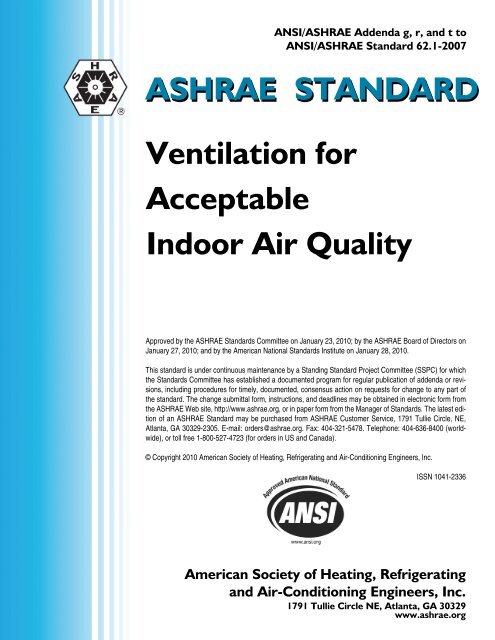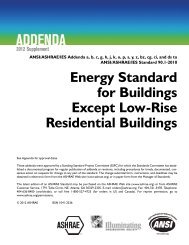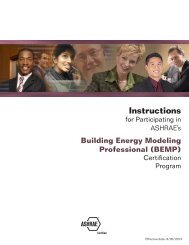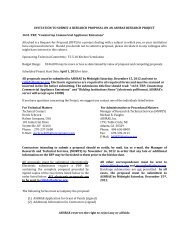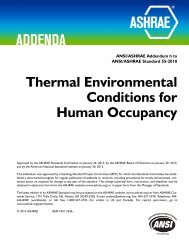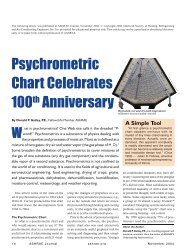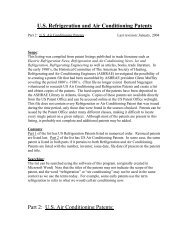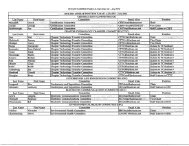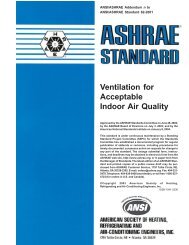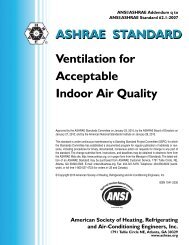ANSI/ASHRAE Standard 62.1-2007 ASHRAE STANDARD Ventilation
ANSI/ASHRAE Standard 62.1-2007 ASHRAE STANDARD Ventilation
ANSI/ASHRAE Standard 62.1-2007 ASHRAE STANDARD Ventilation
Create successful ePaper yourself
Turn your PDF publications into a flip-book with our unique Google optimized e-Paper software.
<strong>ANSI</strong>/<strong>ASHRAE</strong> Addenda g, r, and t to<br />
<strong>ANSI</strong>/<strong>ASHRAE</strong> <strong>Standard</strong> <strong>62.1</strong>-<strong>2007</strong><br />
<strong>ASHRAE</strong> <strong>STANDARD</strong><br />
<strong>Ventilation</strong> for<br />
Acceptable<br />
Indoor Air Quality<br />
Approved by the <strong>ASHRAE</strong> <strong>Standard</strong>s Committee on January 23, 2010; by the <strong>ASHRAE</strong> Board of Directors on<br />
January 27, 2010; and by the American National <strong>Standard</strong>s Institute on January 28, 2010.<br />
This standard is under continuous maintenance by a Standing <strong>Standard</strong> Project Committee (SSPC) for which<br />
the <strong>Standard</strong>s Committee has established a documented program for regular publication of addenda or revisions,<br />
including procedures for timely, documented, consensus action on requests for change to any part of<br />
the standard. The change submittal form, instructions, and deadlines may be obtained in electronic form from<br />
the <strong>ASHRAE</strong> Web site, http://www.ashrae.org, or in paper form from the Manager of <strong>Standard</strong>s. The latest edition<br />
of an <strong>ASHRAE</strong> <strong>Standard</strong> may be purchased from <strong>ASHRAE</strong> Customer Service, 1791 Tullie Circle, NE,<br />
Atlanta, GA 30329-2305. E-mail: orders@ashrae.org. Fax: 404-321-5478. Telephone: 404-636-8400 (worldwide),<br />
or toll free 1-800-527-4723 (for orders in US and Canada).<br />
© Copyright 2010 American Society of Heating, Refrigerating and Air-Conditioning Engineers, Inc.<br />
ISSN 1041-2336<br />
American Society of Heating, Refrigerating<br />
and Air-Conditioning Engineers, Inc.<br />
1791 Tullie Circle NE, Atlanta, GA 30329<br />
www.ashrae.org
<strong>ASHRAE</strong> Standing <strong>Standard</strong> Project Committee <strong>62.1</strong><br />
Cognizant TC: TC 4.3, <strong>Ventilation</strong> Requirements and Infiltration<br />
SPLS Liaison: Robert G. Baker<br />
Staff Liaison: Mark Weber<br />
Dennis A. Stanke, Chair* Francis Michael Gallo Christopher O. Muller<br />
Roger L. Hedrick, Vice-Chair* Diane I. Green Darren B. Meyers<br />
Leon E. Alevantis* Donald C. Herrmann* Lisa J. Rogers*<br />
Michael G. Apte* Eli P. Howard, III* Duane P. Rothstein<br />
Hoy R. Bohanon, Jr. Roger L. Howard* Chandra Sekhar*<br />
Gregory Brunner Wayne M. Lawton Harris M. Sheinman*<br />
Mark P. Buttner Don MacMillan Jeffrey K. Smith<br />
Waller S. Clements* James Patrick McClendon Christine Q. Sun<br />
Leonard A. Damiano* John K. McFarland* Wayne R. Thomann*<br />
Francis J. Fisher, Jr.* Adam S. Muliawan Dilip Y. Vyavaharkar<br />
Vincent T. Galatro Michael W. Woodford*<br />
*Denotes members of voting status when the document was approved for publication.<br />
<strong>ASHRAE</strong> <strong>STANDARD</strong>S COMMITTEE 2009–2010<br />
Steven T. Bushby, Chair Merle F. McBride<br />
H. Michael Newman, Vice-Chair Frank Myers<br />
Robert G. Baker Janice C. Peterson<br />
Michael F. Beda Douglas T. Reindl<br />
Hoy R. Bohanon, Jr. Lawrence J. Schoen<br />
Kenneth W. Cooper Boggarm S. Setty<br />
K. William Dean Bodh R. Subherwal<br />
Martin Dieryckx James R. Tauby<br />
Allan B. Fraser James K. Vallort<br />
Katherine G. Hammack William F. Walter<br />
Nadar R. Jayaraman Michael W. Woodford<br />
Byron W. Jones Craig P. Wray<br />
Jay A. Kohler Wayne R. Reedy, BOD ExO<br />
Carol E. Marriott Thomas E. Watson, CO<br />
Stephanie C. Reiniche, Manager of <strong>Standard</strong>s<br />
SPECIAL NOTE<br />
This American National <strong>Standard</strong> (ANS) is a national voluntary consensus standard developed under the auspices of the American<br />
Society of Heating, Refrigerating and Air-Conditioning Engineers (<strong>ASHRAE</strong>). Consensus is defined by the American National <strong>Standard</strong>s<br />
Institute (<strong>ANSI</strong>), of which <strong>ASHRAE</strong> is a member and which has approved this standard as an ANS, as “substantial agreement reached by<br />
directly and materially affected interest categories. This signifies the concurrence of more than a simple majority, but not necessarily unanimity.<br />
Consensus requires that all views and objections be considered, and that an effort be made toward their resolution.” Compliance with this<br />
standard is voluntary until and unless a legal jurisdiction makes compliance mandatory through legislation.<br />
<strong>ASHRAE</strong> obtains consensus through participation of its national and international members, associated societies, and public review.<br />
<strong>ASHRAE</strong> <strong>Standard</strong>s are prepared by a Project Committee appointed specifically for the purpose of writing the <strong>Standard</strong>. The Project<br />
Committee Chair and Vice-Chair must be members of <strong>ASHRAE</strong>; while other committee members may or may not be <strong>ASHRAE</strong> members, all<br />
must be technically qualified in the subject area of the <strong>Standard</strong>. Every effort is made to balance the concerned interests on all Project<br />
Committees.<br />
The Manager of <strong>Standard</strong>s of <strong>ASHRAE</strong> should be contacted for:<br />
a. interpretation of the contents of this <strong>Standard</strong>,<br />
b. participation in the next review of the <strong>Standard</strong>,<br />
c. offering constructive criticism for improving the <strong>Standard</strong>, or<br />
d. permission to reprint portions of the <strong>Standard</strong>.<br />
DISCLAIMER<br />
<strong>ASHRAE</strong> uses its best efforts to promulgate <strong>Standard</strong>s and Guidelines for the benefit of the public in light of available information and<br />
accepted industry practices. However, <strong>ASHRAE</strong> does not guarantee, certify, or assure the safety or performance of any products, components,<br />
or systems tested, installed, or operated in accordance with <strong>ASHRAE</strong>’s <strong>Standard</strong>s or Guidelines or that any tests conducted under its<br />
<strong>Standard</strong>s or Guidelines will be nonhazardous or free from risk.<br />
<strong>ASHRAE</strong> INDUSTRIAL ADVERTISING POLICY ON <strong>STANDARD</strong>S<br />
<strong>ASHRAE</strong> <strong>Standard</strong>s and Guidelines are established to assist industry and the public by offering a uniform method of testing for rating<br />
purposes, by suggesting safe practices in designing and installing equipment, by providing proper definitions of this equipment, and by providing<br />
other information that may serve to guide the industry. The creation of <strong>ASHRAE</strong> <strong>Standard</strong>s and Guidelines is determined by the need for them,<br />
and conformance to them is completely voluntary.<br />
In referring to this <strong>Standard</strong> or Guideline and in marking of equipment and in advertising, no claim shall be made, either stated or implied,<br />
that the product has been approved by <strong>ASHRAE</strong>.
(This foreword is not part of this standard. It is merely<br />
informative and does not contain requirements necessary<br />
for conformance to the standard. It has not been<br />
processed according to the <strong>ANSI</strong> requirements for a<br />
standard and may contain material that has not been<br />
subject to public review or a consensus process.<br />
Unresolved objectors on informative material are not<br />
offered the right to appeal at <strong>ASHRAE</strong> or <strong>ANSI</strong>.)<br />
FOREWORD<br />
This addendum has been developed in response to a<br />
change proposal; with additional changes resulting from public<br />
review comments. It provides additional information for<br />
demand controlled ventilation (DCV) systems to augment Section<br />
6.2.7 Dynamic Reset.<br />
Note: In this addendum, changes to the current standard<br />
are indicated in the text by underlining (for additions)<br />
and strikethrough (for deletions) unless the instructions specifically<br />
mention some other means of indicating the<br />
changes.<br />
Addendum g to <strong>Standard</strong> <strong>62.1</strong>-<strong>2007</strong><br />
Note: Add the following definition to Section 3 Definitions:<br />
demand controlled ventilation (DCV): any means by which<br />
the breathing zone outdoor air flow (V bz ) can be varied to the<br />
occupied space or spaces based on the actual or estimated<br />
number of occupants and/or ventilation requirements of the<br />
occupied zone.<br />
Note: Revise Section 6.2.7 as follows:<br />
6.2.7 Dynamic Reset. The system may be designed to<br />
reset the design outdoor air intake flow (V ot ) and/or space or<br />
ventilation zone airflow (V oz ) as operating conditions change.<br />
These conditions include but are not limited to:<br />
1. Variations in occupancy or ventilation airflow in one or<br />
more individual zones for which ventilation airflow<br />
requirements will be reset.<br />
Note: Examples of measures for estimating such variations<br />
include: occupancy scheduled by time-of-day, a direct<br />
count of occupants, or an estimate of occupancy or ventilation<br />
rate per person using occupancy sensors such as those based<br />
on indoor CO2 concentrations.<br />
6.2.7.1 Demand Control <strong>Ventilation</strong> (DCV).<br />
6.2.7.1.1 DCV shall be permitted as an optional<br />
means of dynamic reset.<br />
Exception: CO 2-based DCV shall not be applied in zones<br />
with indoor sources of CO 2 other than occupants or with CO 2<br />
removal mechanisms, such as gaseous air cleaners.<br />
6.2.7.1.2 The breathing zone outdoor airflow (V bz )<br />
shall be reset in response to current occupancy and shall be no<br />
less than the building component (R a *A z ) of the DCV zone.<br />
Note: Examples of reset methods or devices include<br />
population counters, carbon dioxide (CO 2 ) sensors, timers,<br />
occupancy schedules or occupancy sensors.<br />
6.2.7.1.3 The ventilation system shall be controlled<br />
such that at steady-state it provides each zone with no less<br />
than the breathing zone outdoor airflow (V bz ) for the current<br />
zone population.<br />
6.2.7.1.4 When the mechanical air-conditioning system<br />
is dehumidifying, the current total outdoor air intake flow<br />
for the building shall be no less than the coincident total<br />
exhaust airflow.<br />
6.2.7.1.5 Documentation: A written description of<br />
the equipment, methods, control sequences, set points, and<br />
the intended operational functions shall be provided. A table<br />
shall be provided that shows the minimum and maximum outdoor<br />
intake airflow for each system.<br />
2.6.2.7.2 <strong>Ventilation</strong> Efficiency. Variations in the<br />
efficiency with which outdoor air is distributed to the<br />
occupants under different ventilation system airflows and<br />
temperatures shall be permitted as an optional basis of<br />
dynamic reset.<br />
3.6.2.7.3 Outdoor Air Fraction. A higher fraction of<br />
outdoor air in the air supply due to intake of additional<br />
outdoor air for free cooling or exhaust air makeup shall be<br />
permitted as an optional basis of dynamic reset.<br />
Note: Modify Section 6.4 as follows:<br />
6.4 Design Documentation Procedures. Design criteria<br />
and assumptions shall be documented and should be made<br />
available for operation of the system within a reasonable time<br />
after installation. See Sections 4.3, 5.2.3, 5.17.4, 6.2.7.1.5,<br />
and 6.3.2 regarding assumptions that should be detailed in the<br />
documentation.<br />
<strong>ANSI</strong>/<strong>ASHRAE</strong> Addenda g, r, and t to <strong>ANSI</strong>/<strong>ASHRAE</strong> <strong>Standard</strong> <strong>62.1</strong>-<strong>2007</strong> 1
(This foreword is not part of this standard. It is merely<br />
informative and does not contain requirements necessary<br />
for conformance to the standard. It has not been<br />
processed according to the <strong>ANSI</strong> requirements for a<br />
standard and may contain material that has not been<br />
subject to public review or a consensus process.<br />
Unresolved objectors on informative material are not<br />
offered the right to appeal at <strong>ASHRAE</strong> or <strong>ANSI</strong>.)<br />
FOREWORD<br />
This addendum modifies the IAQ procedure in Section 6.3<br />
and its description in Section 6.1.<br />
This addendum addresses compliance issues that may<br />
result from unclear wording or phrasing.<br />
This addendum makes a mass balance analysis a<br />
required part of the IAQ procedure.<br />
This addendum requires that performance of IAQ procedure<br />
designed systems be tested similar to the requirements<br />
to test VRP designed systems or that it be based<br />
on the tested performance of a design for a similar zone,<br />
with added requirements for determining whether a zone<br />
is similar.<br />
Note: In this addendum, changes to the current standard<br />
are indicated in the text by underlining (for additions)<br />
and strikethrough (for deletions) unless the instructions specifically<br />
mention some other means of indicating the<br />
changes.<br />
Addendum r to <strong>Standard</strong> <strong>62.1</strong>-<strong>2007</strong><br />
Note: Revise Section 6.1.2 as follows:<br />
6.1.2 IAQ Procedure. This is aThis performance-based<br />
design procedure (presented in Section 6.3), in which the<br />
building, outdoor air intake rates and other system design<br />
parameters are based on an analysis of contaminant sources,<br />
contaminant concentration targetlimits, and level of perceived<br />
indoor air acceptability targets, shall be permitted to be used<br />
for any zone or system. The IAQ Procedure allows credit to<br />
be taken for controls that remove contaminants (for example,<br />
air cleaning devices) or for other design techniques (for example,<br />
selection of materials with lower source strengths) that<br />
can be reliably demonstrated to result in indoor contaminant<br />
concentrations equal to or lower than those achieved using the<br />
<strong>Ventilation</strong> Rate Procedure. The IAQ Procedure may also be<br />
used where the design is intended to attain specific target contaminant<br />
concentrations or levels of acceptability of perceived<br />
indoor air quality.<br />
Note: Revise Section 6.3 as follows:<br />
6.3 Indoor Air Quality (IAQ) Procedure. The Indoor Air<br />
Quality (IAQ) Procedure is a performance-based design<br />
approach in which the building and its ventilation system are<br />
designed to maintain the concentrations of specific contaminants<br />
at or below certain limits identified during the building<br />
design and to achieve the design target level of perceived<br />
indoor air quality acceptability by building occupants and/or<br />
visitors. For the purposes of this procedure, acceptable per-<br />
ceived indoor air quality excludes dissatisfaction related to<br />
thermal comfort, noise and vibration, lighting, and psychological<br />
stressors.<br />
Breathing zone outdoor airflow (V bz ) and/or system<br />
outdoor air intake flow (V ot) shall be determined in accordance<br />
with Sections 6.3.1 thru 6.3.5.<br />
Note: Delete Section 6.3.1:<br />
6.3.1 Designs employing the IAQ Procedure shall comply<br />
with the requirements in the following sections.<br />
Note: Revise Section 6.3.1.1 as follows:<br />
6.3.1.1 Contaminant Sources. Contaminants or mixtures<br />
of concern for purposes of the design shall be identified. For<br />
each contaminant or mixture of concern, indoor sources<br />
(occupants and materials) and outdoor sources shall be<br />
identified, and the strength emission rate for each<br />
contaminant of concern from of each source shall be<br />
determined.<br />
Note: Appendix B lists information for some potential<br />
contaminants of concern.<br />
Note: Revise and Renumber Section 6.3.1.2 as follows:<br />
6.3.1.2 Contaminant Concentration. For each contaminant<br />
of concern, a target concentration limit and its corresponding<br />
exposure period and an appropriate reference to a<br />
cognizant authority shall be specified. (See Appendix B for<br />
some contaminant concentration guidelines.)<br />
Note: Appendix B includes concentration guidelines for<br />
some potential contaminants of concern.<br />
Note: Revise and Renumber Section 6.3.1.3 as follows:<br />
6.3.1.3 Perceived Indoor Air Quality. The criteria to<br />
achieve the design level of indoor air acceptability shall be<br />
specified in terms of the percentage of building occupants and/<br />
or visitors expressing satisfaction with perceived IAQ.<br />
Note: Delete existing Section 6.3.1.4 in its entirety:<br />
6.3.1.4 Design Approaches. Select one or a combination<br />
of the following design approaches to determine minimum<br />
space and system outdoor airflow rates and all other design<br />
parameters deemed relevant (e.g., air-cleaning efficiencies<br />
and supply airflow rates).<br />
a. Mass balance analysis. The steady-state equations in<br />
Appendix D, which describe the impact of air cleaning<br />
on outdoor air and recirculation rates, may be used as<br />
part of a mass balance analysis for ventilation systems<br />
serving a single space.<br />
b. Design approaches that have proved successful in similar<br />
buildings.<br />
c. Approaches validated by contaminant monitoring and<br />
subjective occupant evaluations in the completed building.<br />
An acceptable approach to subjective evaluation is<br />
presented in Appendix B, which may be used to validate<br />
2 <strong>ANSI</strong>/<strong>ASHRAE</strong> Addenda g, r, and t to <strong>ANSI</strong>/<strong>ASHRAE</strong> <strong>Standard</strong> <strong>62.1</strong>-<strong>2007</strong>
the acceptability of perceived air quality in the completed<br />
building.<br />
d. Application of one of the preceding design approaches<br />
(a, b, or c) to specific contaminants and the use of the<br />
<strong>Ventilation</strong> Rate Procedure to address the general<br />
aspects of indoor air quality in the space being designed.<br />
In this situation, the <strong>Ventilation</strong> Rate Procedure would<br />
be used to determine the design ventilation rate of the<br />
space and the IAQ Procedure would be used to address<br />
the control of the specific contaminants through air<br />
cleaning or some other means.<br />
Note: Insert new Section 6.3.4 as follows:<br />
6.3.4 Design Approach. Zone and system outdoor airflow<br />
rates shall be the larger of those determined in accordance<br />
with Section 6.3.4.1 and either 6.3.4.2 or 6.3.4.3, based<br />
on emission rates, concentration limits and other relevant<br />
design parameters (e.g., air cleaning efficiencies and supply<br />
airflow rates).<br />
6.3.4.1 Mass Balance Analysis. Using a steady-state or<br />
dynamic mass-balance analysis, determine the minimum outdoor<br />
airflow rates required to achieve the concentration limits<br />
specified in Section 6.3.2 for each contaminant or mixture of<br />
concern, within each zone served by the system.<br />
Notes:<br />
1. Appendix D includes steady-state mass-balance equations<br />
which describe the impact of air cleaning on outdoor air and<br />
recirculation rates for ventilation systems serving a single zone.<br />
2. In the completed building, measurement of the concentration<br />
of contaminants or mixtures of concern may be useful<br />
as a means of checking the accuracy of the design massbalance<br />
analysis, but such measurement is not required for<br />
compliance.<br />
6.3.4.2 Subjective Evaluation. Using a subjective<br />
occupant evaluation conducted in the completed building,<br />
determine the minimum outdoor airflow rates required to<br />
achieve the level of acceptability specified in Section 6.3.3<br />
within each zone served by the system.<br />
Notes:<br />
1. Appendix B presents one approach to subjective occupant<br />
evaluation.<br />
2. Level of acceptability often increases in response to<br />
increased outdoor airflow rates, increased level of indoor<br />
and/or outdoor air cleaning, or decreased indoor and/or<br />
outdoor contaminant emission rate.<br />
6.3.4.3 Similar Zone. The minimum outdoor airflow<br />
rates shall be no less than those found in accordance with<br />
6.3.4.2 for a substantially similar zone (i.e., in a zone with<br />
identical contaminants of concern, concentration limits, air<br />
cleaning efficiency, and specified level of acceptability; and<br />
with similar contaminant sources and emission rates).<br />
Note: Add Section 6.3.5 as follows:<br />
6.3.5 Combined IAQ Procedure and <strong>Ventilation</strong> Rate<br />
Procedure. The IAQ procedure in conjunction with the <strong>Ventilation</strong><br />
Rate Procedure may be applied to a zone or system. In<br />
this case, the <strong>Ventilation</strong> Rate Procedure shall be used to<br />
determine the required zone minimum outdoor airflow, and<br />
the IAQ Procedure shall be used to determine the additional<br />
outdoor air or air cleaning necessary to achieve the concentration<br />
limits of the contaminants of concern.<br />
Note: The improvement of indoor air quality through the<br />
use of air cleaning or provision of additional outdoor air in<br />
conjunction with minimum ventilation rates may be quantified<br />
using the IAQ procedure.<br />
Note: Revise and Renumber Section 6.3.2 as follows:<br />
6.3.26 Documentation. When the IAQ Procedure is used,<br />
the following information shall be included in the design<br />
documentation: the contaminants of concern considered in the<br />
design process; the sources and source strengths emission<br />
rates of the contaminants of concern; the target concentration<br />
limits and exposure periods and the references for these limits;<br />
the design approach used to control the contaminants of<br />
concern; and the background or justification for this design<br />
approach and the analytical approach used to determine ventilation<br />
rates and air cleaning requirements. If the design is<br />
based on an approach that has proved successful for similar<br />
buildings, the documentation shall include the basis for<br />
concluding that the design approach was successful in the<br />
other buildings and the basis for concluding that the previous<br />
buildings are relevant to the new design. If contaminant monitoring<br />
and occupant evaluation are to be used to demonstrate<br />
compliance, then tThe contaminant monitoring and occupant<br />
and/or visitor evaluation plans shall also be included in the<br />
documentation.<br />
<strong>ANSI</strong>/<strong>ASHRAE</strong> Addenda g, r, and t to <strong>ANSI</strong>/<strong>ASHRAE</strong> <strong>Standard</strong> <strong>62.1</strong>-<strong>2007</strong> 3
(This foreword is not part of this standard. It is merely<br />
informative and does not contain requirements necessary<br />
for conformance to the standard. It has not been<br />
processed according to the <strong>ANSI</strong> requirements for a<br />
standard and may contain material that has not been<br />
subject to public review or a consensus process.<br />
Unresolved objectors on informative material are not<br />
offered the right to appeal at <strong>ASHRAE</strong> or <strong>ANSI</strong>.)<br />
FOREWORD<br />
This addendum modifies Normative Appendix A, and<br />
associated Section 6.2 requirements, as follows:<br />
It reduces compliance issues that may result from<br />
unclear wording or phrasing, especially for VAV systems.<br />
It improves nomenclature consistency between the body<br />
of the standard and the appendix.<br />
It moves key equations from textual definitions to the<br />
body of the Appendix.<br />
It clarifies the design conditions (including minimum<br />
expected discharge airflow and highest expected system<br />
primary airflow) used to calculate worst-case intake<br />
airflow for multiple-zone recirculating systems.<br />
Note: In this addendum, changes to the current standard<br />
are indicated in the text by underlining (for additions)<br />
and strikethrough (for deletions) unless the instructions specifically<br />
mention some other means of indicating the<br />
changes.<br />
Addendum t to <strong>Standard</strong> <strong>62.1</strong>-<strong>2007</strong><br />
Note: Revise Section 3 as follows:<br />
net occupiable space area: the floor area of an occupiable<br />
space defined by the inside surfaces of its walls but excluding<br />
shafts, column enclosures, and other permanently enclosed,<br />
inaccessible, and unoccupiable areas. Obstructions in the<br />
space such as furnishings, display or storage racks, and other<br />
obstructions, whether temporary or permanent, may not be<br />
deducted from the space are considered to be part of the net<br />
occupiable area.<br />
occupiable space: an enclosed space intended for human<br />
activities, excluding those spaces that are intended primarily<br />
for other purposes, such as storage rooms and equipment<br />
rooms, and that are only occupied occasionally and for short<br />
periods of time.<br />
ventilation zone: any indoor area that requires ventilation and<br />
consists of one or more occupied occupiable spaces or several<br />
occupied spaces with similar occupancy category (see Table<br />
6-1), occupant density, zone air distribution effectiveness (see<br />
Section 6.2.2.2), and zone primary airflow (see Section<br />
6.2.5.1) per unit area.<br />
Note: A ventilation zone is not necessarily an independent<br />
thermal control zone; however, spaces that can be<br />
combined for load calculations purposes can often be<br />
combined into a single zone for ventilation calculations<br />
purposes.<br />
Note: Revise Section 6.2 as follows:<br />
6.2 <strong>Ventilation</strong> Rate Procedure. The design outdoor air<br />
intake flow (V ot ) for a ventilation system shall be determined<br />
in accordance with Sections 6.2.1 through 6.2.79.<br />
Note: Revise Section 6.2.2 as follows:<br />
6.2.2 Zone Calculations. <strong>Ventilation</strong> zone parameters<br />
shall be determined in accordance with Sections 6.2.2.1<br />
through 6.2.2.3 for each ventilation zone served by the ventilation<br />
system.<br />
Note: In some cases it is acceptable to determine these<br />
parameters for only selected zones as outlined in Appendix A.<br />
Note: Revise Section 6.2.2.1 as follows:<br />
6.2.2.1 Breathing Zone Outdoor Airflow. The design<br />
outdoor airflow required in the breathing zone of the occupiable<br />
space or spaces in a ventilation zone, i.e., the breathing<br />
zone outdoor airflow (V bz ), shall be no less than the value<br />
determined in accordance with Equation 6-1.<br />
Vbz = Rp · Pz + Ra · Az (6-1)<br />
where:<br />
Az = zone floor area: the net occupiable floor area of<br />
the ventilation zone m2 , (ft2 ) ft2 ,(m2 ).<br />
Pz = zone population: the largest number of people<br />
expected to occupy in the ventilation zone<br />
during typical usage. If the number of people<br />
expected to occupy the zone fluctuates, Pz may<br />
be estimated based on averaging approaches<br />
described in Section 6.2.6.2.<br />
Note: If Pz cannot be accurately predicted during design,<br />
it shall be an estimated value based on the zone floor area and<br />
the default occupant density listed in Table 6-1.<br />
R p = outdoor airflow rate required per person as<br />
determined from Table 6-1.<br />
Note: These values are based on adapted occupants.<br />
R a = outdoor airflow rate required per unit area as<br />
determined from Table 6-1.<br />
Note: Equation 6-1 is the means of accounting accounts<br />
for people-related sources and area-related sources for determining<br />
independently in the determination of the outdoor air<br />
rate required at the breathing zone. The use of Equation 6-1 in<br />
the context of this standard does not necessarily imply that<br />
simple addition of outdoor airflow rates for different sources<br />
can be applied to any other aspect of indoor air quality.<br />
Note: Add a new Section 6.2.2.1.1 as follows:<br />
6.2.2.1.1 Design Zone Population. Design zone population<br />
(Pz ) shall equal the largest (peak) number of people<br />
expected to occupy the ventilation zone during typical usage.<br />
4 <strong>ANSI</strong>/<strong>ASHRAE</strong> Addenda g, r, and t to <strong>ANSI</strong>/<strong>ASHRAE</strong> <strong>Standard</strong> <strong>62.1</strong>-<strong>2007</strong>
Exceptions:<br />
1. If the number of people expected to occupy the ventilation<br />
zone fluctuates, zone population equal to the average<br />
number of people shall be permitted, provided such average<br />
is determined in accordance with Section 6.2.6.2.<br />
2. If the largest or average number of people expected to<br />
occupy the ventilation zone cannot be established for a<br />
specific design, an estimated value for zone population<br />
shall be permitted, provided such value is the product of the<br />
net occupiable area of the ventilation zone and the default<br />
occupant density listed in Table 6-1.<br />
Note: Revise Sections 6.2.2.2 and 6.2.2.3 as follows:<br />
6.2.2.2 Zone Air Distribution Effectiveness. The zone<br />
air distribution effectiveness (E z ) shall be no greater than the<br />
default value determined using Table 6-2.<br />
Note: For some configurations, the default value depends<br />
upon space and supply air temperature.<br />
6.2.2.3 Zone Outdoor Airflow. The design zone outdoor<br />
airflow (V oz ), i.e., the outdoor airflow rate that must be<br />
provided to the ventilation zone by the supply air distribution<br />
system, shall be determined in accordance with Equation 6-2.<br />
V oz = V bz/E z<br />
(6-2)<br />
Note: Revise Sections 6.2.3 and 6.2.4 as follows:<br />
6.2.3 Single-Zone Systems. When For ventilation systems<br />
wherein one or more air handlers supplyies a mixture of<br />
outdoor air and recirculated air to only one ventilation zone,<br />
the outdoor air intake flow (V ot ) shall be determined in accordance<br />
with Equation 6-3.<br />
Vot = Voz (6-3)<br />
6.2.4 100% Outdoor Air Systems. When For ventilation<br />
systems wherein one or more air handlers supplyies only outdoor<br />
air to one or more ventilation zones, the outdoor air<br />
intake flow (Vot ) shall be determined in accordance with<br />
Equation 6-4.<br />
V ot = ∑ all zonesV oz<br />
Note: Revise Section 6.2.5 as follows:<br />
(6-4)<br />
6.2.5 Multiple-Zone Recirculating Systems. When For<br />
ventilation systems wherein one or more air handlers supplyies<br />
a mixture of outdoor air and recirculated return air to<br />
more than one ventilation zone, the outdoor air intake flow<br />
(V ot ) shall be determined in accordance with Sections 6.2.5.1<br />
through 6.2.5.4.<br />
6.2.5.1 Primary Outdoor Air Fraction. When Table 6-<br />
3 is used to determine system ventilation efficiency, the zone<br />
Primary outdoor air fraction (Z pz ) shall be determined for<br />
ventilation zones in accordance with Equation 6-5.<br />
Zpz = Voz/Vpz (6-5)<br />
where Vpz is the zone primary airflow, i.e., the primary airflow<br />
rate to the ventilation zone from the air handler, including<br />
outdoor air and recirculated return air.<br />
Note: For VAV systems, V pz is the minimum expected<br />
primary airflow for design purposes. For VAV-system design<br />
purposes, V pz is the lowest zone primary airflow value<br />
expected at the design condition analyzed.<br />
Note: In some cases it is acceptable to determine these<br />
parameters for only selected zones as outlined in Normative<br />
Appendix A.<br />
6.2.5.2 System <strong>Ventilation</strong> Efficiency. The system ventilation<br />
efficiency (E v ) shall be determined using in accordance<br />
with Table 6-3 or Normative Appendix A.<br />
6.2.5.3 Uncorrected Outdoor Air Intake. The design<br />
uncorrected outdoor air intake (V ou ) flow shall be determined<br />
in accordance with Equation 6-6.<br />
V ou = D∑ all zones (R p · P z ) + ∑ all zones (R a · A z ) (6-6)<br />
6.2.5.3.1 Occupant Diversity. The occupant diversity,<br />
D, may be used to ratio (D) shall be determined in accordance<br />
with Equation 6-7 to account for variations in<br />
occupancy population within the ventilation zones served by<br />
the system. The occupancy diversity is defined as<br />
D=Ps/∑all zones Pz (6-7)<br />
where the system population (Ps ) is the total population in the<br />
area served by the system.<br />
Exception: Alternative methods may be used to account<br />
for population occupant diversity when calculating Vou shall<br />
be permitted, provided that the resulting Vou value is no less<br />
than that determined by using Equation 6-6.<br />
Note: The uncorrected outdoor air intake (V ou ) is<br />
adjusted for occupant diversity but uncorrected it is not<br />
corrected for system ventilation efficiency.<br />
6.2.5.3.2 Design System Population. Design system<br />
population (P s ) shall equal the largest (peak) number of people<br />
expected to occupy all ventilation zones served by the ventilation<br />
system during typical usage.<br />
Note: Design system population is always equal to or less<br />
than the sum of design zone population for all zones in the area<br />
served by the system, since all zones may or may not be simultaneously<br />
occupied at design population.<br />
6.2.5.4 Outdoor Air Intake. The design outdoor air<br />
intake flow (V ot ) shall be determined in accordance with<br />
Equation 6-8.<br />
V ot = V ou /E v<br />
Note: Revise Section 6.2.6 as follows:<br />
<strong>ANSI</strong>/<strong>ASHRAE</strong> Addenda g, r, and t to <strong>ANSI</strong>/<strong>ASHRAE</strong> <strong>Standard</strong> <strong>62.1</strong>-<strong>2007</strong> 5<br />
(6-8)<br />
6.2.6 Design for Varying Operating Conditions.<br />
6.2.6.1 Variable Load Conditions. <strong>Ventilation</strong> systems<br />
shall be designed to be capable of providing no less than the<br />
required minimum ventilation rates required in the breathing<br />
zone whenever the zones served by the system are occupied,<br />
including all full- and part-load conditions.
Note: the minimum outdoor air intake flow may be less<br />
than the design value at part-load conditions.<br />
6.2.6.2 Short-Term Conditions. If it is known that<br />
peak occupancy will be of short duration and/or ventilation<br />
will be varied or interrupted for a short period of time, the<br />
design may be based on the average conditions over a time<br />
period T determined by Equation 6-9a using IP units (Equation<br />
6-9b using SI units):<br />
T =3v / V bz<br />
T =50v / V bz<br />
(6-9a IP)<br />
(6-9b SI)<br />
where:<br />
T = averaging time period, (min).<br />
v = the volume of the ventilation zone for which<br />
averaging is being applied, ft3 (m3 ).<br />
Vbz = the breathing zone outdoor airflow calculated<br />
using Equation 6-1 and the design value of the<br />
zone population (Pz ), cfm (L/s).<br />
Acceptable design adjustments based on this optional<br />
provision include the following:<br />
1. Zones with fluctuating occupancy: The zone population<br />
(P z ) may be averaged over time T.<br />
2. Zones with intermittent interruption of supply air: The average<br />
outdoor airflow supplied to the breathing zone over<br />
time T shall be no less than the breathing zone outdoor<br />
airflow (V bz ) calculated using Equation 6-1.<br />
3. Systems with intermittent closure of the outdoor air intake:<br />
the average outdoor air intake over time T shall be no less<br />
than the minimum outdoor air intake (V ot ) calculated using<br />
Equation 6-3, 6-4, or 6-8 as appropriate.<br />
Note: Revise Table 6-3 as follows:<br />
TABLE 6-3 System <strong>Ventilation</strong> Efficiency<br />
Max (Z pz ) E v<br />
≤ 0.15 1.0<br />
≤ 0.25 0.9<br />
≤ 0.35 0.8<br />
≤ 0.45 0.7<br />
≤ 0.55 0.6<br />
> 0.55 Use Appendix A<br />
1. “Max (Z pz ) ” refers to the largest value of Z pz , calculated using Equation 6-5, among<br />
all the ventilation zones served by the system.<br />
2. For values of Max (Z pz ) between 0.15 and 0.55, one may determine the corresponding<br />
value of E v may be determined by interpolating the values in the table.<br />
3. The values of E v in this table are based on a 0.15 average outdoor air fraction for the<br />
system (i.e., the ratio of the uncorrected outdoor air intake (V ou ) to the total zone<br />
primary airflow for all the zones served by the air handler). For systems with higher<br />
values of the average outdoor air fraction, this table may result in unrealistically low<br />
values of E v and the use of Appendix A may yield more practical results.<br />
Note: Revise Normative Appendix A as follows:<br />
(This is a normative appendix and is part of the<br />
standard.)<br />
NORMATIVE APPENDIX A<br />
MULTIPLE-ZONE SYSTEMS<br />
This appendix presents an alternative procedure for calculating<br />
the system ventilation efficiency (Ev ) that must be used<br />
when Table 6-3 values are not used. In this alternative procedure,<br />
Ev is equal to the lowest calculated value of the zone<br />
ventilation efficiency (Evz ) (see Equation A-38 below). Figure<br />
A.1 contains a ventilation system schematic depicting most of<br />
the quantities used in this appendix.<br />
A.1 System <strong>Ventilation</strong> Efficiency. For any multiple-zone<br />
recirculating system, the system ventilation efficiency (Ev )<br />
shall be calculated in accordance with Sections A1.1 through<br />
A1.3.<br />
A.1.1 Average Outdoor Air Fraction. The average outdoor<br />
air fraction (Xs ) for the ventilation system shall be determined<br />
in accordance with Equation A-1.<br />
X s = V ou/V ps<br />
6 <strong>ANSI</strong>/<strong>ASHRAE</strong> Addenda g, r, and t to <strong>ANSI</strong>/<strong>ASHRAE</strong> <strong>Standard</strong> <strong>62.1</strong>-<strong>2007</strong><br />
(A-1)<br />
Where the uncorrected outdoor air intake (V ou ) is found in<br />
accordance with Section 6.2.5.3, and the system primary<br />
airflow (V ps ) is found at the condition analyzed.<br />
Note: For VAV system design purposes, V ps is the highest<br />
expected system primary airflow at the design condition<br />
analyzed. System primary airflow at design is usually less than<br />
the sum of design zone primary airflow values, since primary<br />
airflow seldom peaks simultaneously in all VAV zones.<br />
A.1.2 Zone <strong>Ventilation</strong> Efficiency. The zone ventilation<br />
efficiency (E vz ) , i.e., the efficiency with which a system distributes<br />
outdoor air from the intake to an individual breathing<br />
zone, shall be calculated using Equation A-1 or A-2.determined<br />
in accordance with Section A.1.2.1 or A.1.2.2<br />
Single Supply Systems E vz = 1+X s –Z d<br />
(A-1)<br />
A.1.2.1 Single-Supply Systems. Equation A-1 (or A-2)<br />
shall be used for For “single-supply” systems, wherein all of<br />
the ventilation air supplied to each ventilation zone is a mixture<br />
of outdoor air and system-level recirculated air, zone<br />
ventilation efficiency (E vz ) shall be determined in accordance<br />
with Equation A-2.from a single location, e.g., Examples of<br />
single-supply systems include constant volume reheat, singleduct<br />
VAV, single-fan dual-duct, and multi-zone systems.<br />
E vz = 1+X s –Z pz<br />
(A-2)<br />
Where the average outdoor air fraction (X s )for the system is<br />
determined in accordance with Equation A-1 and the primary<br />
outdoor air fraction (Z pz ) for the zone is determined in accordance<br />
with Section 6.2.5.1.<br />
General Case<br />
E vz =(F a +X s ·F b –Z d ·F c )/F a<br />
(A-2)
Equation A-2 shall be used for systems that provide all or<br />
part of their ventilation by recirculating air from other zones<br />
without directly mixing it with outdoor air, e.g., dual-fan dualduct,<br />
fan-powered mixing box, and transfer fans for conference<br />
rooms.<br />
A.1.2.2 Secondary Recirculation Systems. For “secondary-recirculation”<br />
systems wherein all or part of the supply<br />
air to each ventilation zone is recirculated air (which has<br />
not been directly mixed with outdoor air) from other zones,<br />
zone ventilation efficiency (E vz ) shall be determined in accordance<br />
with Equation A-3. Examples of secondary-recirculation<br />
systems include dual-fan dual-duct and fan-powered<br />
mixing-box systems, and systems that include transfer fans<br />
for conference rooms.<br />
E vz = (F a + X s · F b – Z pz · E p · F c)/F a<br />
(A-3)<br />
Where system air fractions F a , F b , and F c are determined in<br />
accordance with Equation A-4, A-5 and A-6, respectively.<br />
F a = E p + (1 – E p )· E r<br />
F b = E p<br />
(A-4)<br />
(A-5)<br />
F c = 1 – (1 – E z )·(1 – E r )·(1 – E p ) (A-6)<br />
Where the zone primary air fraction (E p) is determined in<br />
accordance with Equation A-7; zone secondary recirculation<br />
fraction (E r) is determined by the designer based on system<br />
configuration; and zone air distribution effectiveness (E z) is<br />
determined in accordance with Section 6.2.2.2.<br />
Note: For plenum return systems with secondary recirculation<br />
(e.g. fan-powered VAV with plenum return) E r is usually<br />
less than 1.0, although values may range from 0.1 to 1.2<br />
depending upon the location of the ventilation zone relative to<br />
other zones and the air handler. For ducted return systems with<br />
secondary recirculation (e.g., fan-powered VAV with ducted<br />
return), E r is typically 0.0, while for those with system-level<br />
recirculation (e.g, dual-fan dual-duct systems with ducted<br />
return) E r is typically 1.0. For other system types, E r is typically<br />
0.75.<br />
E p = V pz/V dz<br />
Where V dz is zone discharge airflow<br />
(A-7)<br />
Note: For single-zone and single-supply systems, E p is 1.0.<br />
A.1.3 System <strong>Ventilation</strong> Efficiency. The system ventilation<br />
efficiency shall be calculated using equal the lowest zone<br />
ventilation efficiency among all ventilation zones served by<br />
the air handler, in accordance with Equation A-38.<br />
E v = minimum (E vz ) (A-38)<br />
A.2 Alternative Calculations. The above equations may<br />
be rearranged to calculate other design parameters of interest<br />
based on known parameters. This includes, but is not limited<br />
to, calculating minimum zone discharge (supply) airflow<br />
(V dz) when the outdoor air intake flow V ot is known.<br />
Other mMass or flow balance equations for multiple-zone<br />
systems may also be used to determine system ventilation efficiency<br />
and other design parameters, provided that they result<br />
in outdoor air intake airflow (V ot ) that is within 5% of the<br />
airflow value obtained using the system ventilation efficiency<br />
(E v) calculated using Equation A-38 or they more accurately<br />
represent a particular system configuration.<br />
A.3 Design Process. The system ventilation efficiency and<br />
therefore the outdoor air intake flow for the system (V ot ) are<br />
determined as part of the design process are based on the<br />
design and minimum expected supply air flows to individual<br />
ventilation zones as well as the design outdoor air requirements<br />
to the zones. In this process, the designer shall assume<br />
that the critical zone is at its minimum supply or discharge airflow<br />
in VAV systems. For VAV system design purposes, zone<br />
ventilation efficiency (E vz ) for each ventilation zone shall be<br />
found using the minimum expected zone primary airflow<br />
(V pz ), and using the highest expected system primary airflow<br />
(V ps ) at the design condition analyzed.<br />
Note: The designer may increase Increasing the zone<br />
supply air flows values during the design process, particularly<br />
to the critical zones requiring the highest fraction of outdoor<br />
air, and thereby reduces the system outdoor air intake flow<br />
requirement determined in the calculation, sometimes dramatically.<br />
A.3.1 Selecting Zones for Calculation. Zone ventilation<br />
efficiency (E vz ) shall be calculated for all ventilation zones.<br />
Exception: Since system ventilation efficiency (E v) is<br />
determined by the minimum value of the zone ventilation efficiency<br />
(E vz), in accordance with Equation A-38, calculation of<br />
E vz is required only for the zone with the minimum value of<br />
Evz at ventilation design conditions. It is not required for any<br />
ventilation zone thatwhich clearly has an E vz value that is equal<br />
to or larger than that of the ventilation zone for which a calculation<br />
has been done.<br />
Note: The value of E vz for a ventilation zone will have a<br />
larger (or equal) value be equal to or larger than that for<br />
another ventilation zone if all of the following are true relative<br />
to the other ventilation zone with minimum E vz:<br />
1. Floor area per occupant (A z/P z) is no lower<br />
2. Minimum zone discharge airflow rate per unit area (V dz /A z )<br />
is no lower<br />
3. Primary air fraction E p is no lower<br />
4. Zone air distribution effectiveness (E z ) is no lower<br />
5. Area outdoor air rate R a is no higher<br />
6. People outdoor air rate R p is no higher<br />
If all of the above six parameters are the same for different<br />
spaces or areas, then those spaces or areas may be treated as<br />
a single zone for calculation of Evz.<br />
Example: In office buildings it is generally only necessary<br />
to calculate E vz for one typical interior ventilation zone, since<br />
the parameters listed above are generally equal for all interior<br />
spaces. If overhead supply air is used to heat the perimeter, it is<br />
generally also necessary to calculate E vz for the perimeter zone<br />
<strong>ANSI</strong>/<strong>ASHRAE</strong> Addenda g, r, and t to <strong>ANSI</strong>/<strong>ASHRAE</strong> <strong>Standard</strong> <strong>62.1</strong>-<strong>2007</strong> 7
Figure A.1 <strong>Ventilation</strong> system schematic.<br />
with the lowest expected supply primary or discharge airflow<br />
rate per unit area. No other calculations for E vz are typically<br />
necessary, even if the building has 1,000 ventilation zones,<br />
provided the ventilation for any conference rooms or non-office<br />
occupancy zones areis separately calculated.<br />
A.4 SymbolsDefinitions<br />
A z Zone Floor Area: the net occupiable floor area of the ventilation<br />
zone ft 2 (m 2 ).<br />
D Occupant Diversity: the ratio of the system population to<br />
the sum of the zone populations.: D=P s /∑P z .<br />
E p Primary Air Fraction: Primary air the fraction of primary<br />
air in the discharge air to the ventilation zone: E p = V pz /V dz (E p<br />
= 1.0 for single-duct and single-zone systems).<br />
E r Secondary Recirculation Fraction: In systems with<br />
secondary recirculation of return air, the fraction of secondary<br />
recirculated air to the zone that is representative of average<br />
system return air rather than air directly recirculated from the<br />
zone.<br />
Note: For plenum return systems with local secondary<br />
recirculation (e.g., fan-powered VAV with plenum return), Er<br />
≤ 1.0. For ducted return systems with local secondary recircu-<br />
lation(e.g.,fan-poweredVAVwithductedreturn),typicallyEr<br />
= 0.0.<br />
E v System <strong>Ventilation</strong> Efficiency: the efficiency with which<br />
the system distributes air from the outdoor air intake to the<br />
breathing zone in the ventilation-critical zone, which requires<br />
the largest fraction of outdoor air in the primary air stream.<br />
Note: E v is may be determined from Table 6-3in accordance<br />
with Section 6.2.5.2 or Equation A-3Section A.1.<br />
E vz Zone <strong>Ventilation</strong> Efficiency: the efficiency with which<br />
the system distributes air from the outdoor air intake to the<br />
breathing zone in any particular ventilation zone. E vz is determined<br />
from Equations A-1 or A-2.<br />
E z Zone Air Distribution Effectiveness (E z ): a measure of<br />
how effectively the effectiveness of the zone supply air distribution<br />
uses its supply air to maintain acceptable air quality into<br />
the breathing zone. Note: E z is determined in accordance with<br />
Section 6.2.2.2from Table 6-2.<br />
F a Supply Air Fraction: Fraction The fraction of supply air<br />
to the ventilation zone that includes from sources of air from<br />
outside the zone: F a =E p +(1–E p )·E r .<br />
F b Mixed Air Fraction: The fraction of supply air to the<br />
ventilation zone from fully mixed primary air: F b =E p .<br />
8 <strong>ANSI</strong>/<strong>ASHRAE</strong> Addenda g, r, and t to <strong>ANSI</strong>/<strong>ASHRAE</strong> <strong>Standard</strong> <strong>62.1</strong>-<strong>2007</strong>
F c Outdoor Air Fraction: The fraction of outdoor air to the<br />
ventilation zone that includes from sources of air from outside<br />
the zone: F c =1–(1–E z )·(1–E r )·(1–E p ).<br />
P s System Population: the maximum simultaneous number<br />
of occupants in the area served by the ventilation system.<br />
Where population fluctuates, it may be averaged as described<br />
in Section 6.2.6.2.<br />
P z Zone Population: the largest number of people expected to<br />
occupy the zone during typical usage. If Pz is not known, it is<br />
determined from the default occupant densities listed in Table<br />
6-1. Where population fluctuates, it may be averaged as<br />
described in Section 6.2.6.2.see Section 6.2.2.1.<br />
R a Area Outdoor Air Rate: the outdoor airflow rate per unit<br />
area to be provided in the breathing zone to dilute contaminants<br />
that are emitted at a rate that is related more to floor area<br />
than to population. The value of Ra for a zone is determined<br />
from Table 6-1.see Section 6.2.2.1.<br />
R p People Outdoor Air Rate: the outdoor airflow rate per<br />
person to be provided in the breathing zone to dilute contaminants<br />
that are emitted at a rate that is related more to population<br />
than to floor area. The value of Rp for a zone is determined<br />
from Table 6-1.see Section 6.2.2.1.<br />
V bz Breathing Zone Outdoor Airflow: the outdoor airflow<br />
required in the breathing zone of an occupiable space, Vbz<br />
=Rp·Pz+Ra·Az.see Section 6.2.2.1.<br />
V dz Zone Discharge Airflow: The expected discharge<br />
(supply) airflow to the zone that includes primary airflow and<br />
locallysecondary recirculated airflow, cfm (L/s).<br />
Vot Outdoor Air Intake Flow: the design outdoor airflow<br />
required at the ventilation system outdoor air intake.see<br />
Sections 6.2.3, 6.2.4, 6.2.5.4.<br />
Vou Uncorrected Outdoor Air Intake: The outdoor air intake<br />
flow required if the system ventilation efficiency Ev were 1.0.<br />
Vou=D·∑Rp·Pz+∑Ra · Az.see Section 6.2.5.3.<br />
Voz Zone Outdoor Airflow: the design outdoor airflow<br />
required in the zone, i.e., Voz = Vbz/Ez.see Section 6.2.2.3.<br />
Vps System Primary Airflow: The total primary airflow<br />
supplied to all zones served by the system from the airhandling<br />
unit at which the outdoor air intake is located, Vps= ∑Vpz, in cfm (L/s).<br />
Vpz Zone Primary Airflow: The primary airflow supplied to<br />
the zone from the air-handling unit at which the outdoor air<br />
intake is located, L/s (cfm). It includes outdoor intake air and<br />
recirculated air from that air-handling unit but does not include<br />
air transferred or air recirculated to the zone by other<br />
means.see Section 6.2.5.1.<br />
Xs Average Outdoor Air Fraction: At the primary air<br />
handler, the fraction of outdoor air intake flow in the system<br />
primary airflow, Xs = Vou /Vps .<br />
Z d Discharge Outdoor Air Fraction: The outdoor air fraction<br />
required in air discharged to the zone, Z d = V oz /V dz .<br />
Note: For VAV systems, Vdz is the minimum expected<br />
discharge airflow for design purposes.<br />
Z pz Primary Outdoor Air Fraction: The outdoor air fraction<br />
required in the primary air supplied to the ventilation zone<br />
prior to the introduction of any secondary recirculation air<br />
<strong>ANSI</strong>/<strong>ASHRAE</strong> Addenda g, r, and t to <strong>ANSI</strong>/<strong>ASHRAE</strong> <strong>Standard</strong> <strong>62.1</strong>-<strong>2007</strong> 9
POLICY STATEMENT DEFINING <strong>ASHRAE</strong>’S CONCERN<br />
FOR THE ENVIRONMENTAL IMPACT OF ITS ACTIVITIES<br />
<strong>ASHRAE</strong> is concerned with the impact of its members’ activities on both the indoor and outdoor environment. <strong>ASHRAE</strong>’s<br />
members will strive to minimize any possible deleterious effect on the indoor and outdoor environment of the systems and<br />
components in their responsibility while maximizing the beneficial effects these systems provide, consistent with accepted<br />
standards and the practical state of the art.<br />
<strong>ASHRAE</strong>’s short-range goal is to ensure that the systems and components within its scope do not impact the indoor and<br />
outdoor environment to a greater extent than specified by the standards and guidelines as established by itself and other<br />
responsible bodies.<br />
As an ongoing goal, <strong>ASHRAE</strong> will, through its <strong>Standard</strong>s Committee and extensive technical committee structure,<br />
continue to generate up-to-date standards and guidelines where appropriate and adopt, recommend, and promote those new<br />
and revised standards developed by other responsible organizations.<br />
Through its Handbook, appropriate chapters will contain up-to-date standards and design considerations as the material is<br />
systematically revised.<br />
<strong>ASHRAE</strong> will take the lead with respect to dissemination of environmental information of its primary interest and will seek<br />
out and disseminate information from other responsible organizations that is pertinent, as guides to updating standards and<br />
guidelines.<br />
The effects of the design and selection of equipment and systems will be considered within the scope of the system’s<br />
intended use and expected misuse. The disposal of hazardous materials, if any, will also be considered.<br />
<strong>ASHRAE</strong>’s primary concern for environmental impact will be at the site where equipment within <strong>ASHRAE</strong>’s scope<br />
operates. However, energy source selection and the possible environmental impact due to the energy source and energy<br />
transportation will be considered where possible. Recommendations concerning energy source selection should be made by<br />
its members.


